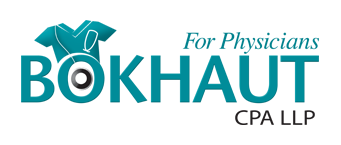
Dec 20, 2022
Many physicians in Canada have incorporated their practices, as there are significant tax benefits to doing so.
This then provides incorporated doctors with two avenues to donation:
- Corporate Donations
- Personal Donations
We are often asked, “should I make donations from my corporation, or make them personally?”
The answer is “it depends”, but the tax differential between corporate and personal donation is usually insignificant.
Generally, donations made from personal funds are more beneficial when you are in a lower personal tax bracket, as the tax credit rate may be higher than your average personal tax rate.
For example, if you had taxable income of around $155,000, your average personal tax rate in Manitoba would be ~33%, but the tax credit you would receive on donations greater than $200 is 46.40%.
Ex. If you donated $5,200, in the 33% tax bracket, you would receive a tax refund for your donation:
|
Personal Donation |
| Tax Rate |
33% A |
| Personal Income Used for Donation |
$5,200 B |
| Tax on Income (A * B) |
$1,716 C |
| Less: Donation tax credit |
*(2,372) D |
| Tax Refund on $5,200 of Income (C– D) |
$656 E |
| *See Part 1 for calculation of credit |
In contrast, donations made through the corporation provide roughly the same benefit when you are in the top personal tax bracket (example below).
If you donate $5,200 personally, in the top tax bracket (50.40%), the donation credit received would not fully offset the tax levied on $5,200 of income due to the lower credit (25.80%) received on the first $200 of donations.
|
Personal Donation |
| Top Personal Tax Rate in MB |
50.40% A |
| Personal Income Used for Donation |
$5,200 B |
| Tax on $5,200 of Income (A * B) |
$2,621 C |
| Less: Donation tax credit |
*(2,572) D |
| Tax Payable on $5,200 of Income (C– D) |
$49 E |
| *See Part 1 for calculation of credit |
If you instead donated the $5,200 directly from your medical corporation, the result would be as follows:
|
Corporate Donation |
| Corporate Income |
$5,200 |
| Less: Donation |
(5,200) |
| Taxable Income |
Nil |
| Corporate Tax |
Nil |
Tax difference = $49
($49 personal tax – $0 corporation tax)
Unlike the donation tax credit system used for personal tax calculation, eligible donations made with corporate funds are fully deductible from corporate income up to a maximum of 75% of the corporation’s net income each year.
Donations made through a medical corporation are subject to the same eligibility rules as donations claimed on a personal tax return.
Please see “Month of Giving (Part 1): Donation Tax Credit Refresher” for more information on eligibility rules. https://bokhaut.ca/month-of-giving-part-1-donation-tax-credit-refresher/
If you would like a consultation regarding tax for physicians, please contact us.
* This article was prepared on December 20, 2022. Content is for informational purposes only and is not intended to be used as professional advice. Each taxpayer’s circumstances are unique. Bokhaut CPA makes no representation as to the accuracy and completeness of the information in this article and will not be liable for any errors or omissions in this information.

Dec 19, 2022
December is the month of giving.
While deciding which charitable organizations you wish to support this year, the following donation tax credit information is good to keep in mind:
What qualifies as a donation for tax purposes?
To qualify for the donation tax credit, gifts must be made to a registered charity.
Gifts can include cash, securities, and various forms of other property.
CRA has an online listing of registered charities and organizations that are considered qualified “donees” here: https://www.canada.ca/en/revenue-agency/services/charities-giving/list-charities/list-charities-other-qualified-donees.html
What if you receive something in return for the donation?
If you receive a benefit in return for your gift (ex. tickets or a meal), the value of the benefit must be subtracted from the value of the gift to arrive at the ‘eligible’ donation amount.
This benefit must also not exceed 80% of the gift.
For example, Dr. X buys a table at a hospital gala for $5,000. The cost of the food and beverages for the evening is $1,500. The hospital foundation would then issue them a gift receipt for $3,500 ($5,000-$1,500).
Are there limits on the amount of donations you can claim in a year?
An individual or medical corporation can claim donations up to 75% of their net income each year.
Unused donation credits can be ‘carried forward’ for up to 5 years to be claimed on a future tax return.
Can you claim donations to U.S. entities?
Generally, donations to U.S. entities are only claimable if you have U.S. source income, and, you can only claim an amount up to 75% of the net U.S. source income.
U.S. entities are considered charities if they are exempt from tax in the U.S. and may qualify as a Canadian registered charity if they are based in Canada.
What supporting documentation is required for the claim?
An official donation receipt is required to support any donation credit claim. The following items are among the information that must be included on an official receipt:
- Name and address of the issuing organization
- Registered charity number
- Name of donor
- Amount of donation
- Amount of eligible donation
- Date the donation had been received
- Date the receipt had been issued
- Serial number to specifically identify the receipt
Can you claim donations made by your spouse or common-law partner?
Unlike most other tax credits or deductions, you can claim donations made by your spouse or common-law partner on your return.
You cannot claim donations made by any other individual (ex. your child).
How is the personal donation credit calculated?
There are both federal and provincial portions of a donation tax credit. In Manitoba, the combined donation credit rates are below:
- The first $200 of charitable donations receive a credit of 25.80%.
If you are married or have a common law partner, it generally makes sense to claim all donations made by both spouses/partners on one return to limit the donations that receive the lower credit rate.
- If total donations exceed $200, the amount exceeding $200 receives a credit of 40%.
There is an additional 4% federal tax credit on donations over $200, to the extent that income is taxed at the top marginal tax rate.
If for example, a physician is in the top tax bracket and made $5,200 in donations to registered charities, they would receive a combined federal and provincial tax credit of $2,571.60 (calculation below).
First $200: 200 @ 25.80% = $51.60
Amounts over $200: $5,000 @ 46.40% = $2,320
Additional Credit: $5,000 @ 4% = $200
Total Credit = $2,571.60
If you would like a consultation regarding tax for physicians, please contact us.
* This article was prepared on December 19, 2022. Content is for informational purposes only and is not intended to be used as professional advice. Each taxpayer’s circumstances are unique. Bokhaut CPA makes no representation as to the accuracy and completeness of the information in this article and will not be liable for any errors or omissions in this information.

Dec 9, 2022
As the holiday season approaches, it is not unusual for doctors to provide gifts to their employees, hospital administrative staff, colleagues, and nurses.
While these gifts are generous gestures, they may result in unexpected tax implications.
Gifts to Employees
When it comes to gifts provided to employees, the CRA has clear guidelines regarding what is, and more-importantly, what is not taxable.
An employee is an individual who is paid directly by you/your corporation, with tax withheld, in return for work completed. Employees are generally paid via salary and receive a T4 at the end of the year. Employees are not equivalent to contractors, for whom you may not withhold taxes.
The tax implications of the gift depend on a few factors:
- Does it meet the definition of ‘gift’ as outlined by the CRA?
A gift to an employee, by CRA’s standards, is given in connection with a special occasion (religious holiday, birthday, wedding, etc.) and is not related to their employment or job performance.
CRA has identified 3 categories of gifts:
- Cash
- ‘Near-cash’
- ‘Non-cash’
Summary of Tax Implications of Employee Gifts
Cash:
- Deductible to the corporation
- Taxable to the employee (T4 Slip)
- Requires withholdings – income tax, CPP, and EI
Near Cash:
- Deductible to the corporation
- Taxable to the Employee (T4 Slip)
- Withholdings required – income tax and CPP (No EI)
Non-Cash:
- Deductible to the corporation
- Sometimes taxable to the employee (T4 Slip)
- Withholdings Required [*if taxable]- income tax and CPP (No EI)
*Only if the amount is taxable based on the ‘non-cash’ gift rules explained below.
Taxable:
Cash gifts are simply cash or cheques. Cash gifts are always taxable to the employee and are subject to income tax, CPP, and EI premium withholdings.
‘Near-cash’ gifts include items such as prepaid credit cards, or easily convertible property such as securities or cryptocurrency. ‘Near-cash’ gifts are also taxable to the employee but are only subject to income tax and CPP premium withholdings.
Taxable gifts must be included on the employee’s T4.
Non-Taxable:
‘Non-cash’ gifts include items such as tickets to an event or a gift basket. Essentially, ‘non-cash’ gifts are redeemable for specific items or events with no option for the employee to choose the item/event or exchange it for money.
If the total value of ‘non-cash’ items gifted to an individual employee during the year is less than $500, the gifts are non-taxable to the employee. Amounts exceeding $500 are taxable to the employee and are subject to income tax and CPP premium withholdings.
Items of minimal value, such as cups, mugs, or t-shirts, are not taxable and should not be included in the calculation of ‘non-cash’ gifts.
Non-taxable gifts do not need to be included on the employee’s T4.
Gift Cards
Canada Revenue Agency has recently updated its administrative position on gift cards.
Historically, gift cards were considered a ‘near-cash’ gift and were always taxable to the employee.
This year the CRA has identified that gift cards may in fact be a ‘non-cash’, therefore non-taxable, gift to employees, if it meets the following conditions:
- The value of the card is under $500.
- It comes with money already on it and can only be used to purchase goods or services from a single retailer or a group of retailers identified on the card.
- The terms and conditions of the gift card clearly state that amounts loaded to the card cannot be converted into cash.
- A log is kept recording gift card information containing all the following:
- Name of the employee.
- Date the gift card was provided to the employee.
- Reason for providing the gift card (part of social event, gift, or award).
- Type of gift card.
- Amount of the gift card.
- Name of the retailer(s).
This includes gift certificates, chip cards and electronic gift cards. If the gift card meets all these conditions, it is considered non-cash for the purpose of the CRA’s administrative policy. If the card does not meet these conditions, it is considered a near-cash benefit and is taxable.
Gifts to Non-Employees
Often, doctors and their medical corporations give gifts to individuals that they do not employ, such as department administrative staff, nurses, colleagues, or professional advisors.
As these individuals are not employees of the doctor there is generally no obligation to report the gift as income nor withhold tax.
Gifts in this case could be considered advertising/promotion costs, which are generally deductible against practice income. The deductibility of gifts in this case is subject to the typical business expense deductibility tests:
- Is the expense related to the income generating activity of the corporation?
If a gift helps to establish or maintain professional relationships, there would be an argument that the cost is associated with the income producing activity of the corporation, as it enhances the current and future revenues of the business.
For example, a gift to a colleague who regularly refers patients to your practice.
- Is the amount of the expense reasonable?
Even if an expense is arguably related to income producing activity, the value of the gift in relation to the benefit to the business must be considered.
Using the above example, purchasing a gift basket of wine, chocolate, coffee, etc. for your colleague could be a reasonable expense given the benefit received by your practice. In contrast, purchasing an all-expense paid vacation to Maui for the same colleague as a gift would likely be viewed as an unreasonable expense.
If you have questions on the above, please contact us to book a consult.
Happy holidays!

Nov 21, 2022
There is a lot to think about when you buy your first home. What colour should you paint the living room? What should the extra bedroom be used for? A home office? A gym? Or maybe a nursery?
Outside of aspirational objectives, there are many practical matters that need to be considered. This article provides a basic overview of some of the financial considerations of purchasing a house.
Down Payment:
How much to put down?
To qualify for a mortgage, you will need to make a down payment equal to at least 5% of the purchase price of the property.
If you put less than 20% down, you are required to pay for mortgage insurance through CMHC (Canada Mortgage and Housing Corporation).
If you can put down 20% or more you can avoid the CMHC insurance.
Saving for a Down Payment
You should also consider saving for your down payment by contributing to your RRSP (to use the Home Buyers Plan) or the First Home Savings Account (available starting 2023).
- RRSP: If you have funds in your RRSP, you can borrow those funds using the ‘Home Buyers Plan’ (HBP). You and your spouse can each withdraw up to $35,000 from your RRSP accounts on a tax-free basis. This amount is then repaid to the RRSP over 15 years.
- FHSA: The First Home Savings Account is a tax-deductible savings account that allows first time Canadian home buyers to save up to $40,000 for a down payment. Contributions to this account offer a tax deduction on your personal tax return. Unlike the HBP, withdrawn funds never need to be repaid. Effectively, this allows you to put $40,000 of earnings towards a down payment, which are never taxable to you.
To learn more about the Home Buyers Plan and FHSA, click here: https://bokhaut.ca/fhsaupdates/
Deposit and Closing Costs:
So, you have all the funds required to make a down payment on the house of your dreams, but do you have cash available to make a deposit at the time of the offer? What about the closing costs?
Deposit
When you make an offer on a house, you are encouraged to pay a deposit. The deposit shows the seller that you are serious about the purchase and that you intend to complete the deal. There is no set amount required for a deposit, but if there are multiple offers, a large deposit may tip the scales in your favour.
To make a deposit, you would need cash available in your chequing account. If all your savings for the house are in the RRSP or FHSA, this may restrict your ability to do so, as there can be processing delays on withdrawing the funds.
Closing Costs – Offer Has Been Accepted
If your offer has been accepted, you must have, by the date of possession, financing in place and funds to pay the closing costs. The closing costs include (but are not limited to) Land Transfer taxes, legal fees and CMHC insurance fees (if your down payment is less than 20%).
Land transfer taxes in Manitoba are calculated on a graduated scale, with 0% on the first $30,000, increasing up to 2% on any amount over $200,000.
Legal fees vary based on the law firm but are generally several thousand dollars.
If you are purchasing a condo, there may be additional fees such as a contribution to the reserve fund.
Fees can add up quickly, so it’s important to get an idea of what the ancillary costs are before you make an offer.
Tax credits and rebates:
- If you are a first-time home buyer, you are eligible to claim the ‘First Time Home Buyers’ Tax Credit. This is claimed on your personal tax return and provides a benefit of $1,500 in tax savings.
- If you build a new house or buy a newly built house, there will be GST charged on the purchase. You can claim a GST rebate to recover some of the GST paid. In Manitoba you can claim a rebate for 36% of the GST paid up to a maximum of $6,300. Often if you purchase the house from a builder, the builder will help you apply for this rebate. If the property Is located in Ontario or Nova Scotia, there may be additional rebates available through the provincial governments.
- There should be no GST charged on the purchase of a pre-owned home, unless the home has been substantially renovated. A substantial renovation is considered to have taken place if all or considerably all the interior of the building has ben replaced.
If you are a physician and have questions on the above, please contact us.
* This article was prepared on October 22, 2022. Content is for informational purposes only and is not intended to be used as professional advice. Each taxpayer’s circumstances are unique. Bokhaut CPA makes no representation as to the accuracy and completeness of the information in this article and will not be liable for any errors or omissions in this information.


Nov 4, 2022
Overall Analysis:
New details were scarce in the 2022 Fall Economic Statement; for the most part, the Honorable Chrystia Freeland provided more detail on the 2022 Budget Proposals.
In summary, the provisions most relevant for physicians were as follows:
- PROPOSAL: Permanent elimination of interest on Canada Student Loans, beginning April 1, 2023. Due to Covid-19 the government waived interest on student loans for two years, this proposal would eliminate interest permanently. This includes student loans that are currently being repaid.
- The GST credit will be doubled for the next six months. Payments of increased GST credit begin today, November 4th, 2022.
- Rural physicians will be eligible for a maximum debt forgiveness of $60,000 (previously $40,000), effective April 1, 2023.
The following provisions are effective 2023 and remain largely unchanged from the 2022 Budget:
- The First Home Savings Account (FHSA) will allow Canadians to save up to $40,000 for a down payment for their first home, tax-free. The specific start date of the program has yet to be announced.
For more information on this program, visit: https://bokhaut.ca/fhsaupdates/
- The First-Time Home Buyers’ Tax Credit will be doubled, increasing the total tax savings to up to $1,500.
- The Multigenerational Home Renovation Tax Credit will be introduced, providing up to $7,500 in support for constructing a suite for a family member who is a senior or an adult with a disability.
- Profits on homes purchased and held for less than 12 months will be fully taxable (in lieu of capital gains treatment) and will not be eligible for the Principal Residence Exemption. This provision is intended to target house flipping. However, there may be exceptions for certain life events.
We expect further details on these programs to be announced in the Spring 2023 Federal Budget.
* This article was prepared on November 4, 2022. Content is for informational purposes only and is not intended to be used as professional advice. Each taxpayer’s circumstances are unique. Bokhaut CPA makes no representation as to the accuracy and completeness of the information in this article and will not be liable for any errors or omissions in this information.





